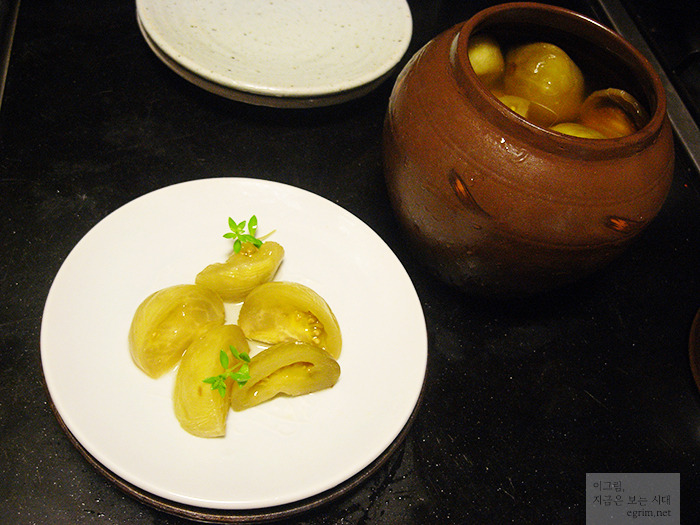Chewy Tomato Jangajji (Pickled Tomatoes) – Refreshing and Delicious
How to Make Delicious Tomato Jangajji, Not Salty, Like Pickles

Introducing a simple yet incredibly delicious recipe for Tomato Jangajji! It’s a perfect side dish for rice, and also works wonderfully in salads or sandwiches. This jangajji is delicately seasoned and incredibly tasty.
Main Ingredients- 1.5kg ripe but firm tomatoes
- 1/2 cup coarse sea salt
Brine Seasoning- 1 cup Korean soy sauce (Guk-ganjang)
- 1 cup vinegar (rice vinegar or apple cider vinegar recommended)
- 1/2 cup sugar (white or brown sugar)
- 1 cup water
- 1 handful dried mugwort leaves (optional, for added aroma)
- A pinch of whole peppercorns
- 2 red chili peppers, sliced diagonally after removing seeds
- 1/2 cup yuja (citron) preserve or syrup
- 1 cup Korean soy sauce (Guk-ganjang)
- 1 cup vinegar (rice vinegar or apple cider vinegar recommended)
- 1/2 cup sugar (white or brown sugar)
- 1 cup water
- 1 handful dried mugwort leaves (optional, for added aroma)
- A pinch of whole peppercorns
- 2 red chili peppers, sliced diagonally after removing seeds
- 1/2 cup yuja (citron) preserve or syrup
Cooking Instructions
Step 1
Wash the firm, green tomatoes thoroughly. Remove the stems and cut each tomato in half. Sprinkle coarse sea salt evenly onto the cut surfaces. Let them salt for about half a day (12 hours).

Step 2
After salting, rinse the tomatoes gently under cold water to remove excess saltiness. Drain them very well. You’ll notice the tomatoes become firmer and chewier as some of their moisture is removed during this process.

Step 3
Place the drained tomatoes in a colander or on a drying rack. Let them air dry in a well-ventilated area for about a day until they become slightly shriveled and chewy. If you’re short on time, you can pat them dry with a clean kitchen towel or cheesecloth to remove excess moisture.

Step 4
Now, let’s prepare the brining liquid! Combine the Korean soy sauce, vinegar, sugar, and water in a saucepan.

Step 5
Add the mugwort leaves (if using), whole peppercorns, and sliced red chilies to the saucepan with the other brine ingredients. Bring the mixture to a boil over medium heat. Once it boils vigorously, reduce the heat and simmer for a minute. Then, turn off the heat. Remove the mugwort, peppercorns, and chilies. Let the brine cool completely. The yuja preserve will be added later.

Step 6
Sterilize your glass jars by washing them thoroughly and drying them. Pack the dried tomatoes snugly into the sterilized jars. Once the brine is completely cool, pour it over the tomatoes, ensuring they are fully submerged. I used an abalone shell and a small stone to keep the tomatoes pressed down. Allow the jangajji to mature for about 15 days before consuming.

Step 7
If you find the brine has reduced or you’d like to intensify the flavor, you can carefully pour out the brine after about 3 days, re-boil it, let it cool completely, and then pour it back into the jars. Repeating this process once more will deepen the flavor. It’s best to store the jangajji in the refrigerator. You can keep the entire jar in the fridge and take out a few tomatoes at a time to enjoy whole or halved.

Step 8
Here’s a look at the tomato jangajji after about a month of maturing. It has turned a lovely light yellow, reminiscent of ginkgo leaves.

Step 9
Doesn’t it have a beautiful color? Tomato jangajji is most delicious enjoyed as is, without any additional seasoning. Adding sesame seeds or sesame oil can alter the delicate flavor, so it’s not recommended. The choice of salt or soy sauce for pickling depends on the ingredients. Using a very dark soy sauce can dull the fresh color and texture of the tomatoes. For tomatoes, using Korean soy sauce (Guk-ganjang) and salt together results in a prettier color and a more pleasing taste than using regular dark soy sauce.




